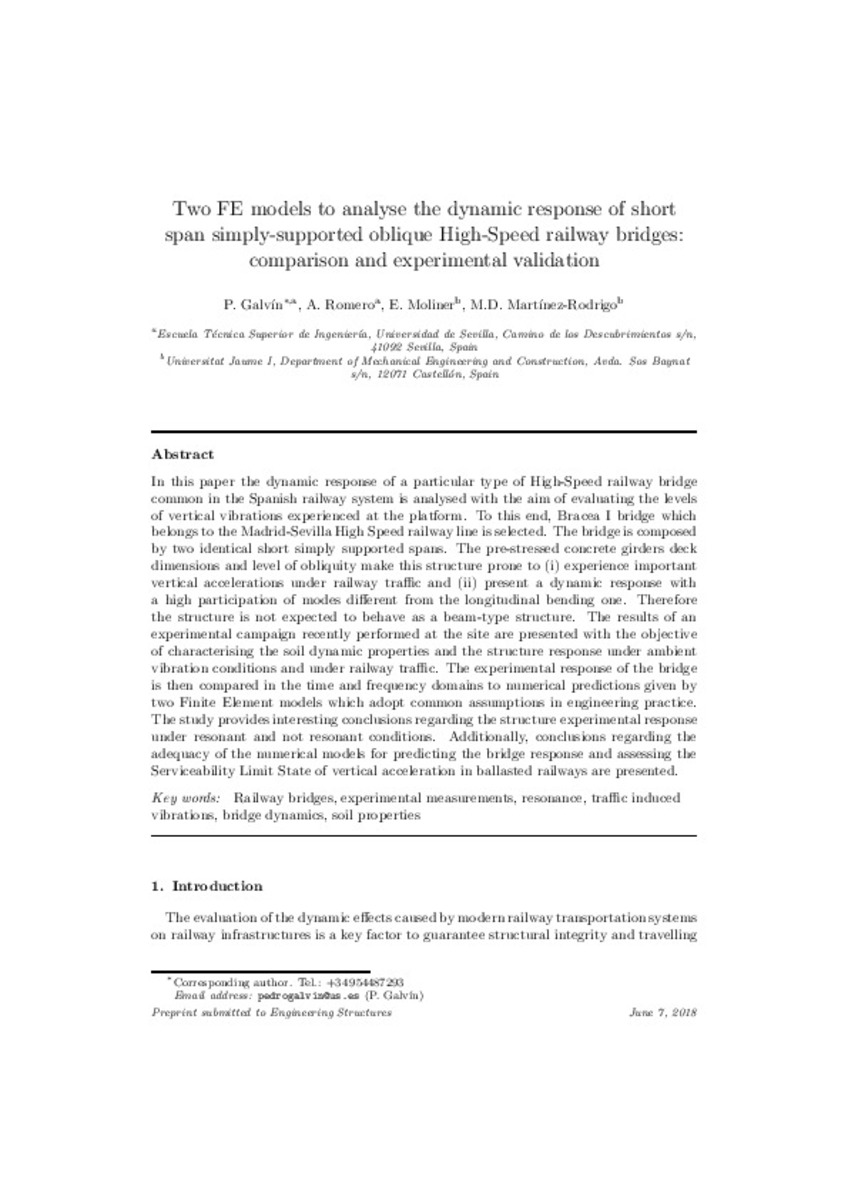Mostrar el registro sencillo del ítem
Two FE models to analyse the dynamic response of short span simply-supported oblique high-speed railway bridges: Comparison and experimental validation
| dc.contributor.author | Galvín, Pedro | |
| dc.contributor.author | Romero Ordóñez, Antonio | |
| dc.contributor.author | Moliner, Emma | |
| dc.contributor.author | Martínez-Rodrigo, María D. | |
| dc.date.accessioned | 2018-06-08T06:37:45Z | |
| dc.date.available | 2018-06-08T06:37:45Z | |
| dc.date.issued | 2018-07-15 | |
| dc.identifier.citation | GALVÍN, Pedro; ROMERO, Antonio; MOLINER CABEDO, Emma; MARTÍNEZ-RODRIGO, María D. (2018). Two FE models to analyse the dynamic response of short span simply-supported oblique high-speed railway bridges: Comparison and experimental validation. Engineering Structures, v. 167, p. 48-64 | ca_CA |
| dc.identifier.uri | http://hdl.handle.net/10234/175034 | |
| dc.description.abstract | In this paper the dynamic response of a particular type of high-speed railway bridge common in the Spanish railway system is analysed with the aim of evaluating the levels of vertical vibrations experienced at the platform. To this end, Bracea I bridge which belongs to the Madrid-Sevilla High Speed railway line is selected. The bridge is composed by two identical short simply supported spans. The pre-stressed concrete girders deck dimensions and level of obliquity make this structure prone to (i) experience important vertical accelerations under railway traffic and (ii) present a dynamic response with a high participation of modes different from the longitudinal bending one. Therefore the structure is not expected to behave as a beam-type structure. The results of an experimental campaign recently performed at the site are presented with the objective of characterising the soil dynamic properties and the structure response under ambient vibration conditions and under railway traffic. The experimental response of the bridge is then compared in the time and frequency domains to numerical predictions given by two Finite Element models which adopt common assumptions in engineering practice. The study provides interesting conclusions regarding the structure experimental response under resonant and not resonant conditions. Additionally, conclusions regarding the adequacy of the numerical models for predicting the bridge response and assessing the Serviceability Limit State of vertical acceleration in ballasted railways are presented. | ca_CA |
| dc.format.extent | 29 p. | ca_CA |
| dc.format.mimetype | application/pdf | ca_CA |
| dc.language.iso | cat | ca_CA |
| dc.publisher | Elsevier | ca_CA |
| dc.relation.isPartOf | Engineering Structures (2018), v. 167 | ca_CA |
| dc.rights.uri | http://rightsstatements.org/vocab/CNE/1.0/ | * |
| dc.subject | Railway bridges | ca_CA |
| dc.subject | Experimental measurements | ca_CA |
| dc.subject | Resonance | ca_CA |
| dc.subject | Traffic induced vibrations | ca_CA |
| dc.subject | Bridge dynamics | ca_CA |
| dc.subject | Soil properties | ca_CA |
| dc.title | Two FE models to analyse the dynamic response of short span simply-supported oblique high-speed railway bridges: Comparison and experimental validation | ca_CA |
| dc.type | info:eu-repo/semantics/article | ca_CA |
| dc.identifier.doi | https://doi.org/10.1016/j.engstruct.2018.03.052 | |
| dc.relation.projectID | 19 Spanish Ministry of Economy and Competitiveness under the research project [BIA2013-43085-P]; 2) the Andalusian Scientific Computing Centre (CICA) and (iii) Universitat Jaume I under the research project [P1-1B2015-54]; 3) This work falls within the initiation of research project BIA2016-75042-C2 financed by the Spanish Ministry of Economy and Competitiveness. | ca_CA |
| dc.rights.accessRights | info:eu-repo/semantics/openAccess | ca_CA |
| dc.relation.publisherVersion | https://www.sciencedirect.com/science/article/pii/S0141029617332649 | ca_CA |
| dc.type.version | info:eu-repo/semantics/publishedVersion | ca_CA |
Ficheros en el ítem
Este ítem aparece en la(s) siguiente(s) colección(ones)
-
EMC_Articles [816]







